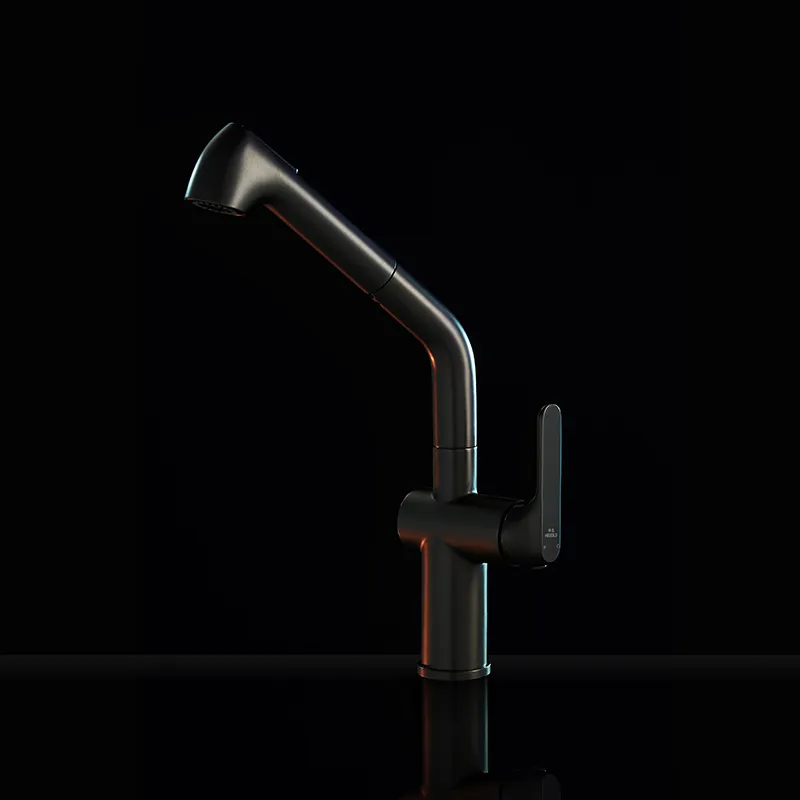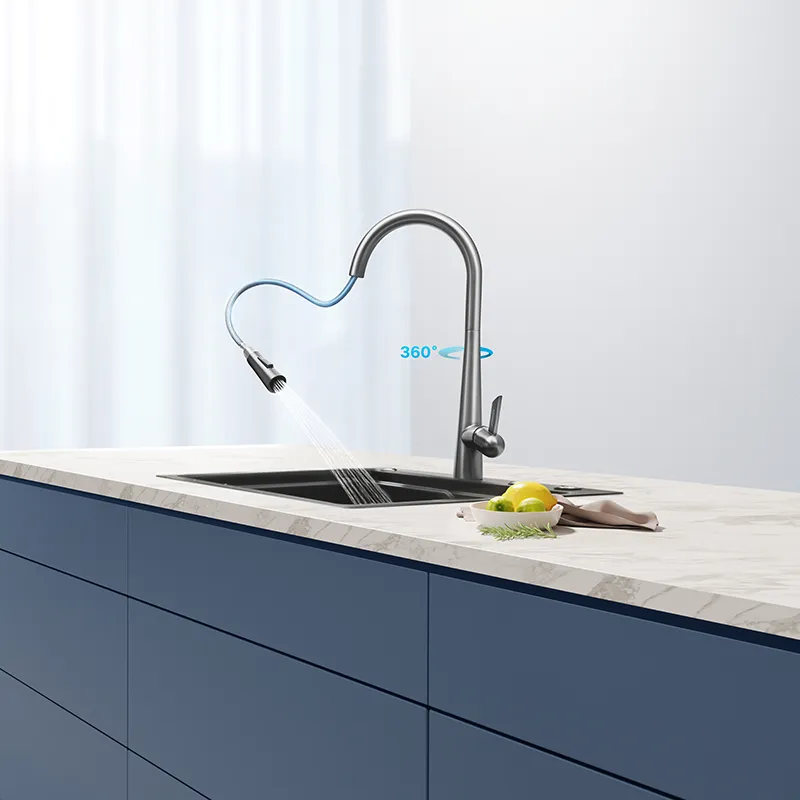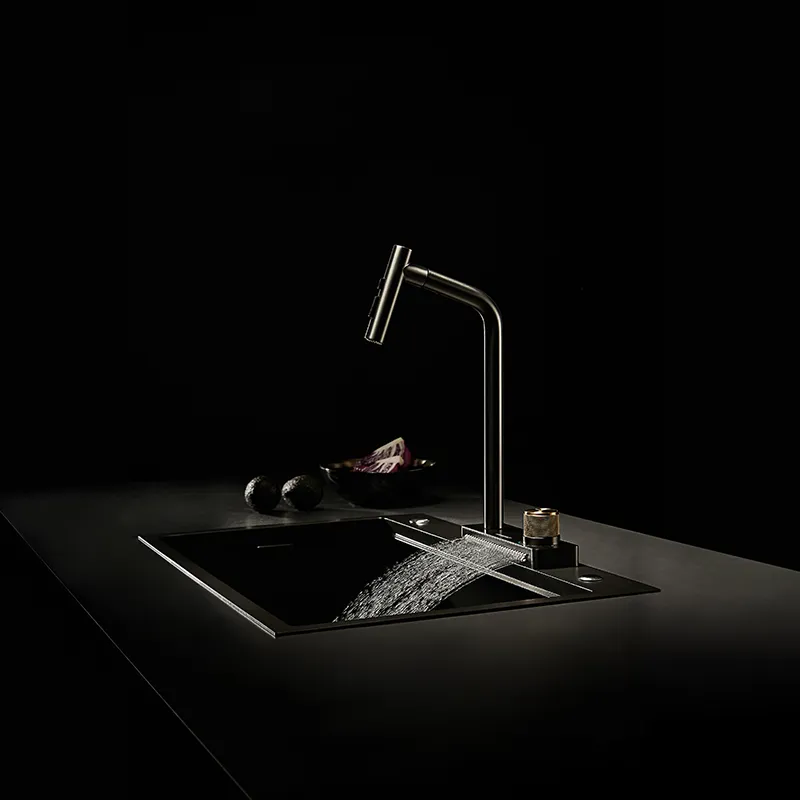Compared to the traditional low-profile designs of the past, today's kitchen sink faucets are generally designed to be taller, longer, and more flexible—a trend seen in almost all modern kitchens. Many people wonder during renovations: why are kitchen sink faucets so tall now? Is this design merely for aesthetics, or are there deeper practical reasons?
This article will systematically and professionally analyze the real reasons for the increased height of kitchen sink faucets, exploring this from multiple perspectives, including ergonomics, cleaning needs, space adaptation, functional design, and user experience.

Why are modern kitchen sink faucets generally taller than in the past?
The change in kitchen sink faucet height is not accidental, but rather the result of the combined effects of kitchen usage habits, cleaning needs, and advancements in ergonomics. In the past, kitchens primarily featured low double sinks with short-spout faucets. However, with larger kitchen units and more diverse cooking methods, the need for more washing space has significantly increased.
The biggest advantage of tall faucets is that they provide a more spacious washing area.
Whether washing pots and pans, rinsing fruits and vegetables, or filling large kettles, a high enough kitchen sink faucet avoids the problems of bending over, bumping into things, or splashing water. Furthermore, a high spout allows users to more easily place large containers, no longer limited by the faucet's height.
What is the real benefit of a high kitchen sink faucet design?
Many users mistakenly believe that high faucets are merely a symbol of a "modern" appearance, but this height design actually combines practicality and comfort.
1. Increased Usability
High faucets provide a greater range of motion for daily kitchen operations. Users can easily rotate or move the spout to clean every corner of the sink. Especially when combined with an extendable spray nozzle, it allows for more efficient rinsing of residue and foam.
2. Better Fit for Deep Sinks
Modern kitchens commonly use deep sinks, typically over 20cm deep. To avoid excessive arm bending or touching the water flow area, the height of the kitchen sink faucet is also raised, allowing the water flow to fall naturally at a comfortable level for comfortable use.
3. Reduced Splashing and Fatigue
Ergonomically optimized kitchen sink faucets are typically positioned between 45-60cm. This height allows for a more vertical water flow angle, reducing splashing; it also minimizes bending over during washing, reducing fatigue during prolonged use.

Are tall kitchen sink faucets more convenient for washing large items?
The answer is yes.
Washing large items such as pots, pans, cutting boards, and baking trays is one of the most common tasks in the kitchen. With traditional low faucets, problems often arise such as pots not fitting in the sink, incomplete rinsing, and water splashing everywhere from the pot's edge. Tall faucets solve these problems.
• Easier to place large pots or woks: The high spout provides ample space, easily rinsing even a 32cm diameter wok.
• Improved washing efficiency: The combination of high water pressure and a wide-angle water flow removes grease and residue more quickly.
• Convenient multi-angle rinsing: Many tall kitchen sink faucets feature rotating nozzles, allowing for flexible direction adjustment and a more thorough cleaning of the sink's interior.
Therefore, height is not merely a result of design changes, but a necessary choice to meet the needs of modern kitchen use.
How does the height of a kitchen sink faucet affect water usage comfort?
The comfort of kitchen operations is closely related to the faucet height. If the faucet is too low, it leads to frequent bending and cramped operation; if it is too high, the large water drop can easily cause splashing. An ideal kitchen sink faucet design typically determines the appropriate height based on the following factors:
Sink depth:
• Shallow depth (<18cm) → Suitable for medium-tall faucets (approximately 30-35cm)
• Deep depth (>20cm) → Suitable for high-curve faucets (40-50cm)
Water outlet angle and curvature design:
Tall faucets, with their curved or L-shaped spouts, allow the water flow angle to be closer to the center, thus improving rinsing precision.
Standing Height:
A reasonable faucet height should allow the user to naturally place their hands in the center of the sink while standing, without needing to bend over or raise their arms significantly. This design conforms to ergonomic principles, making use more comfortable and natural.

What are the common structural types of tall kitchen sink faucets?
To balance aesthetics and practicality, modern tall kitchen sink faucets have a wide variety of structural designs. Here are some common types and their characteristics:
1. High-Curve Fixed Faucet
• Advantages: Simple design, suitable for various kitchen styles.
• Features: Fixed spout but with ample space, suitable for daily cleaning tasks.
2. Extendable Kitchen Sink Faucet
• Advantages: Extendable spray head, switchable between spray/direct current modes.
• Features: Particularly suitable for washing large kitchen utensils or double sink areas.
3. Rotary Tall Faucet
• Advantages: Spout can rotate 180° or 360°, convenient for switching between double sinks.
• Features: Commonly found in residential double-bowl or island kitchen designs.
4. Commercial High-Pressure Spray Faucet
• Advantages: Powerful spray, high cleaning efficiency.
• Features: Primarily used in open kitchens or cooking spaces where efficient cleaning is prioritized.
These designs are all based on a common goal: to ensure that the height of the kitchen sink faucet meets functional requirements while enhancing the user experience.
Will a high kitchen sink faucet cause more splashing?
Many users worry that high faucets will cause water to splash. In fact, this is often related to an improper match between the sink depth and the faucet.
If the kitchen sink is too shallow and the faucet is too high, the water drop difference will indeed cause splashing. Therefore, when choosing a kitchen sink faucet, the following points should be considered:
Sink and faucet matching ratio:
• Deep sink + high faucet → Perfect combination, reduces splashing.
• Shallow sink + high faucet → Requires an aerator or adjustment of the water flow mode.
Aerator Design at the Spout:
Modern tall faucets generally feature an air-injection aerator that disperses the water flow into soft bubbles, significantly reducing splashing.
Water Flow Angle Adjustment:
Adjusting the spout angle or choosing a kitchen sink faucet with an adjustable nozzle allows for precise control of the water flow direction, ensuring it falls directly into the center of the sink.
When properly matched, tall faucets not only prevent splashing but also provide a cleaner and more comfortable washing experience.
What are the Hidden Advantages of Tall Kitchen Sink Faucets?
Besides appearance and ease of cleaning, tall kitchen sink faucets offer some less obvious practical advantages:
1. Greater Installation Flexibility
Taller faucets typically use a standard orifice design, compatible with countertop, undermount, and built-in sink structures.
2. Enhanced Visual Depth
In modern kitchen designs, tall faucets create a vertical visual contrast with wall cabinets and the cooktop, increasing the sense of space and dimension.
3. Easy to Maintain
Tall faucets typically feature chrome plating, stainless steel, or brushed finishes, making them corrosion-resistant, less prone to scale buildup, and easier to clean.
4. Compatible with Water Purification Systems and Multifunctional Spouts
Many tall kitchen sink faucets can be connected to a water purification system, allowing for switching between hot and cold water and purified water, increasing kitchen convenience.

How to Choose the Right Height for Your Kitchen Sink Faucet?
To ensure your kitchen sink faucet functions effectively, choosing the right height is crucial. Here are some practical tips for purchasing:
• Choose according to sink depth: Deep sinks require tall faucets, while shallow sinks require medium-height faucets.
• Prioritize spout angle: Curved or L-shaped spout designs reduce splashing.
• Check the rotation angle: For double sink designs, a 360° rotating spout is recommended.
• Consider installation space: If there are wall cabinets or a windowsill on the countertop, ensure the faucet's opening height is not restricted.
A well-designed faucet height not only improves kitchen efficiency but also extends the lifespan of the appliance.
What sales materials does Higold provide for its partners?
Higold supports buyers with product catalogs, high-resolution images, technical drawings, and promotional videos. These materials can be customized with the buyer’s branding, making it easier for distributors and retailers to market products effectively. Professional sales kits reduce marketing costs for wholesale buyers and accelerate time-to-market.


